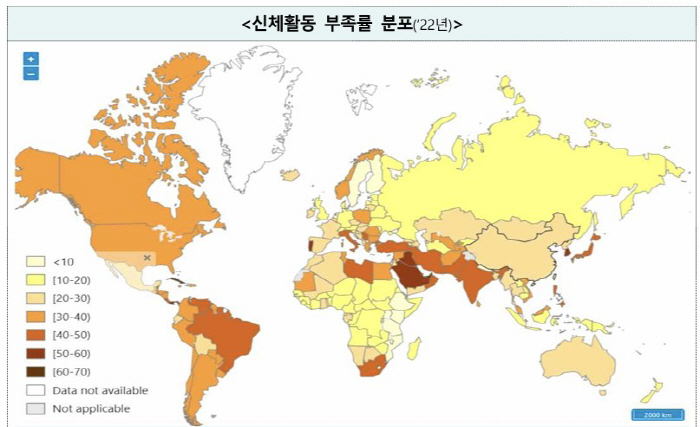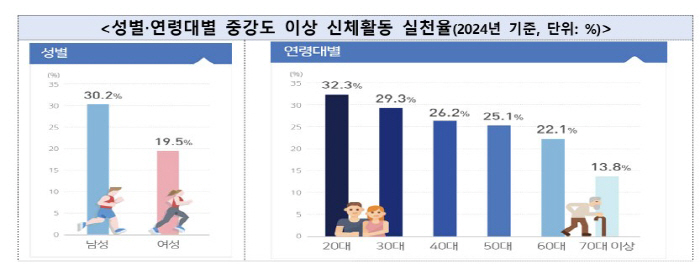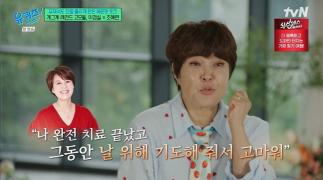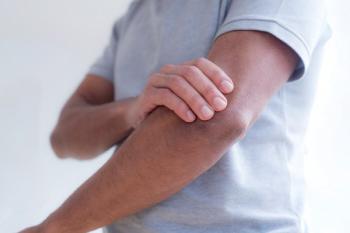Lack of physical activity in Korea, nearly double the global average
Jul 10, 2025
|
|
This is the result of a detailed analysis of the annual 'community health survey' conducted by the Korea Centers for Disease Control and Prevention along with 17 metropolitan governments, 258 health centers, and 33 local universities.
The percentage of adults who practice high-intensity physical activity more than 20 minutes a day or more than three days a week or more of medium-intensity physical activity for more than 30 minutes a day or more than five days a week is calculated, including all physical activities according to professional activities.
The medium-intensity physical activity practice rate is a little harder and a little short of breath than usual, slow swimming, doubles tennis, volleyball, badminton, table tennis, and light carrying activities, and the community health survey excludes walking in the medium-intensity physical activity practice rate. The high-intensity physical activity practice rate includes physical activity that is very difficult and short of breath than usual, running (jogging), hiking, cycling at a high speed, fast swimming, soccer, basketball, jump rope, squash, singles tennis, and carrying heavy objects.
The rate of practice of physical activity above the medium-intensity level of adults in Korea is 19.7% in 2021, the lowest since the statistical calculation, and is gradually recovering, and 26.6% in 2024, above the pre-COVID-19 level. Looking at the trend over the past decade, it remained stagnant for several years before rising slightly (2.4%p↑) in 2019, just before the COVID-19 pandemic, but fell sharply (4.9%p↓) in 2020 due to the impact of the pandemic. Since then, daily recovery has begun in 2022 and is gradually on the rise.
By gender, men showed a difference of 10.7%p with 30.2% and women 19.5%, and by age, those in their 20s were the highest at 32.3% and the lowest at 13.8% among those in their 70s and older. The results of the regression analysis also showed that men were 1.7 times higher than women, and those in their 20s were 2.1 times higher than those over 70.
In addition, the tendency to decrease physical activity above the medium intensity by age group was noticeable in men. 42.2% of men in their 20s practiced physical activity above the medium-intensity level, the highest, while only 18.3% of men in their 70s and older practiced physical activity, the lowest. On the other hand, in the case of women, there was no clear decrease in participation in physical activity above moderate intensity with age. Among women, the practice rate tended to be higher among middle-aged women in the order of 40s (22.9%) and 50s (21.8%).
However, the walking practice rate in 2024 is 57.0% for those in their 60s and 50.6% for those over 70 years old, indicating that they are performing light physical activities such as walking rather than medium-intensity physical activities in old age. In the case of women, physical activity above medium-intensity was the highest in their 40s, while the walking practice rate was the lowest, showing contradictory patterns.
On the other hand, it was found that there was a significant difference in the practice rate according to chronic diseases and mental health conditions. The practice rate of adults with no experience of diagnosing hypertension or diabetes was 26.8%, which was 7.2%p higher than that of the group with diagnostic experience (19.6%). Regression analysis results also showed that the rate of physical activity practice above the medium intensity of the group with no experience in diagnosing hypertension or diabetes was significantly 1.1 times higher than that of the group with experience.
In addition, the practice rate of the population group without depressive symptoms was 25.1%, 7.8%p higher than that of the group with depressive symptoms (17.3%), and the regression analysis showed that those who had not experienced depressive symptoms were 1.2 times higher.
The Korea Centers for Disease Control and Prevention emphasized that it is important to regularly practice not only light movements in daily life but also physical activities above the medium intensity of shortness and sweating to prevent chronic diseases as well as improve mental health. In particular, activities such as hiking, running, and cycling are effective in preventing and improving major chronic diseases, and at the same time, they are known to contribute to mental health promotion such as reducing depression, relieving stress, and alleviating anxiety disorders.
Meanwhile, the rate of lack of physical activity, which is the proportion of adults who did not practice medium-intensity physical activity for more than 150 minutes or high-intensity physical activity for more than 75 minutes in a week, was also pointed out as a problem.
Ji Young-mi, the head of the Korea Centers for Disease Control and Prevention, said, `Physical activity above moderate intensity is essential for improving healthy aging and quality of life beyond disease prevention.' If this is neglected, it can have a negative impact on health, such as the risk of chronic diseases as well as poor mental health" he warned. It is encouraging that the rate of physical activity practice above the medium-intensity level has been increasing since the recovery of daily life. The rate of lack of physical activity among adults around the world is 31.3% as of 2022, while the rate of lack of physical activity among adults in Korea is 58.1% at the same time, which is 1.9 times higher. It is important to continue small movements that can be practiced in everyday life, from light exercise to breathless exercise. He emphasized the active physical activity practice of the whole nation.
This article was translated by Naver AI translator.















